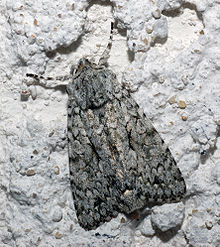Grey chi
| Antitype chi | |
|---|---|

| |
| Scientific classification | |
| Domain: | Eukaryota |
| Kingdom: | Animalia |
| Phylum: | Arthropoda |
| Class: | Insecta |
| Order: | Lepidoptera |
| Superfamily: | Noctuoidea |
| Family: | Noctuidae |
| Genus: | Antitype |
| Species: | A. chi
|
| Binomial name | |
| Antitype chi | |
| Synonyms | |
| |
The grey chi (.



This species has grey forewings speckled with black markings which vary in intensity (with the female generally more heavily marked than the male). There is usually a bold cross-shaped black mark in the centre of the wing which has been likened to the Greek letter chi (Χ) and gives the species its common name. The hindwings are white in the male, dirty grey in the female.
Technical description and variation
A. chi L. (33 i, 34 a). Forewing chalk white, grey-speckled; the lines double, grey; median area darker, the stigmata pale grey and conspicuous; the claviform at extremity edged with black and joined by a black dash to the inner blacker arm of outer line; submarginal line formed of whitish spots preceded by black wedge shaped marks; hindwing of male white with interrupted grey submarginal band; of female blackish grey, with darker cellspot, veins, and outer line; the females are always darker grey than the males; — olivacea Stph. (34 a) from Scotland is suffused throughout with olive grey; — subcaerulea Graes., from N. E. Amurland, is dark bluish grey in the forewing;- suitusa Robson is a dark grey form from the North of England, of which the males are equally dark with the females an extreme local development of this form from the neighbourhood of Huddersfield, Yorkshire, ab. nigrescens Tutt is nearly black; ab. langei Harrison (34 a) is like olivacea but the submarginal line is absent, and the black marks preceding it wholly or nearly obsolete. Larva green, finely dotted with yellow; dorsal and subdorsal lines whitish; spiracular line yellowish white, diffusely dark green above .[1]
Biology
This moth flies at night in August and September[1] and is attracted to light and sugar.
The
- ^ The flight season refers to the British Isles. This may vary in other parts of the range.
Subspecies
- Antitype chi chi
- Antitype chi subcaerulea (Graeser, 1889) (Russian Far East)
Recorded food plants
- Artemisia - mugwort
- Convallaria - lily-of-the-valley
- Helianthus - Jerusalem artichoke
- Lactuca - lettuce
- Lathyrus - meadow vetchling
- Lychnis- campion
- Ribes - blackcurrant
- Rumex
- Salix - willow
- Saxifraga - saxifrage
- Sedum - stonecrop
- Silene - campion
- Sonchus - sow thistle
- Taraxacum - dandelion
- Triglochin
- Urtica - stinging nettle
- Viburnum - guelder rose
See.[2]
References
- ^ Warren. W. in Seitz, A. Ed., 1914 Die Großschmetterlinge der Erde, Verlag Alfred Kernen, Stuttgart Band 3: Abt. 1, Die Großschmetterlinge des palaearktischen Faunengebietes, Die palaearktischen eulenartigen Nachtfalter, 1914
 This article incorporates text from this source, which is in the public domain.
This article incorporates text from this source, which is in the public domain.
- ^ Robinson, Gaden S.; Ackery, Phillip R.; Kitching, Ian J.; Beccaloni, George W.; Hernández, Luis M. (2010). "Search the database - introduction and help". HOSTS - A Database of the World's Lepidopteran Hostplants. Natural History Museum, London.
- Chinery, Michael (1986, reprinted 1991). Collins Guide to the Insects of Britain and Western Europe.
- Skinner, Bernard (1984). The Colour Identification Guide to Moths of the British Isles.
External links
- Kimber, Ian. "73.228 BF2254 Grey Chi Antitype chi (Linnaeus, 1758)". UKMoths. Retrieved 30 June 2019.
- Savela, Markku. "Antitype chi (Linnaeus, 1758)". Lepidoptera and Some Other Life Forms. Retrieved June 30, 2019. Taxonomy
- Fauna Europaea
- Lepiforum e.V.
